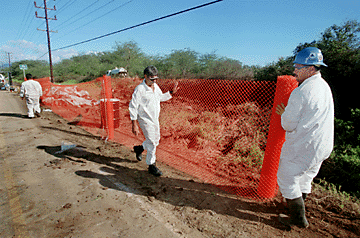


Oil spill
threatens bird
sanctuary
State and federal agencies
By Lori Tighe
combine efforts to find the source
of the leak; buried oil drums
may be to blame
Star-BulletinLeaking oil is just 100 feet from a sanctuary for Hawaii's four endangered water bird species near Pearl Harbor, but the source of the growing spill remains a mystery.
About 22 gallons of a "weathered" diesel fuel have pooled on the ground and oozed from underground since Jan. 29 on Navy-owned vacant land behind the Leeward Community College area. Weathered means it's been there for years.
The area has a history of oil spills from old pipelines, said Gary Gill, deputy director of the state Health Department.
The Navy, which owns the land, is continuing to dig with help from state and federal agencies to find the spill's source and stop it.
The Navy and Chevron said they feel certain their nearby pipelines aren't leaking. They believe buried oil drums are causing the problem.
"We continue to see fuel as we dig," said Margo Stahl, assistant manager for Oahu refuges for U.S. Fish & Wildlife. "We're most worried that we don't know the source or extent of the oil spill. But we're confident everyone is taking it seriously and we'll get to the bottom of it."
Stahl fears the spill may leak to the 25-acre Pearl Harbor National Wildlife Refuge, Waiawa unit. It is home to the state's four endangered species of water birds: the Hawaiian stilt, coot and duck; and the moor hen.
The birds could be harmed through direct contact with the oil or by ingesting it, she said.
With Chevron's help, U.S. Fish & Wildlife took the precautionary measure of laying booms, or giant sponges, at the entrance of the refuge's water sources. The booms would absorb fuel leaking to the water.
People have dumped old cars and refrigerators in the area for years, said Lt. Cmdr. Rod Gibbons.
The puddle, 25-by-10-feet big and about a foot deep, was discovered Jan. 29. Part water and part fuel, it was giving off a petroleum smell.
Concerned because it hadn't found the source of the leak, the Navy returned this week to look again.
Then someone stepped in muck and a bluish-yellow liquid oozed out, Gibbons said. "The troubling thing is, there's diesel fuel making its way to the surface. We're all concerned."